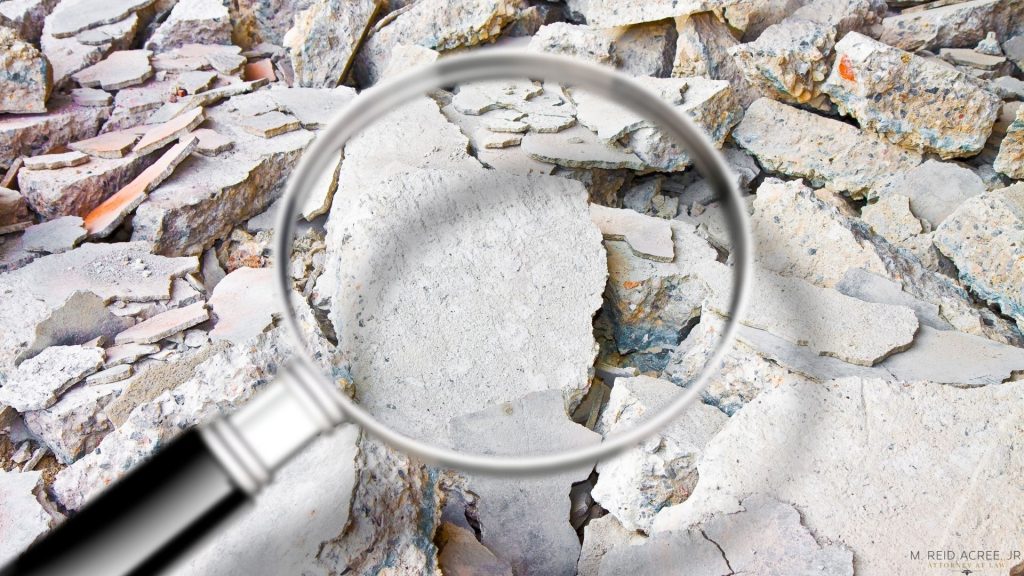
Call for FREE CONSULTATION
No Attorney Fee Unless You Win
704.633.0860
Asbestosis and Cancer Attorney in North Carolina

A very large part of Mr. Acree’s practice in Salisbury focuses on the diseases of asbestosis and asbestos-related cancers. Most of these cases involve workers (such as pipe fitters, welders, sheet metal mechanics, electricians, and construction workers) who were exposed to the hazards of asbestos in industrial settings. Benefits may be obtained from the employer (typically through workers’ compensation), the land owner and/or the manufacturer of the asbestos-containing products. First, what is asbestosis?
What Is Asbestosis?
Asbestosis is defined as “a characteristic fibrotic condition of the lung caused by the inhalation of asbestos dust.” N. C. Gen. Stat. §97-62. When an individual breathes asbestos dust, the normal defense mechanisms of the nose, throat and lung prevent some of the asbestos bodies from lodging in the lung. Many asbestos fibers get by these early defense mechanisms and lodge in the lower part of the lung where they are attacked by protective white blood cells which engulf the asbestos fibers. Some of these cells are injured and altered by the asbestos fibers. The injured cells then release chemicals that induce the lung tissue to form fibrotic scars. Wilner, Asbestos Medicine on Trial, p. 14 (1995). When the lung is sufficiently scarred, an individual cannot process the oxygen that he or she breathes in. As a result, the individual will experience shortness of breath on exertion and in severe cases will have shortness of breath even at rest. Roggli, Pathology of Asbestos-Associated Diseases (1992).
In 1930, a few years before asbestosis was listed as an occupational disease by the North Carolina Workers’ Compensation Act, Dr. E.R.A. Mereweather performed the first epidemiological study on asbestos workers. “This study established beyond all reasonable doubt that excessive exposure to asbestos fibers can produce asbestosis. Searcy-Alfred, A Guide to Toxic Torts, §20.01 (23) [a] (1999). Dr. Mereweather described the effects of asbestosis as follows: “[t]his disease, insidious in its onset, steadily advances with but faint warning of its progress; inexorably it cripples the essential tissue of the lung, yet for a considerable period causes almost no inconvenience to the worker. As time goes on, however, the lungs find more and more difficulty re-aerating the blood and breathing is quickened on slight exertions.” Mereweather, The Occurrence of Pulmonary Fibrosis and Other Pulmonary Afflictions in Asbestos Workers, J. Indust. Hyg., 12:198-222, 239-257 (1930).
Asbestos-Related Cancers
Innumerable studies and papers have been presented concerning the health hazards of asbestos. It has been estimated that over 50,000 cancer cases per year are caused by exposure to asbestos. Bridboard, Estimates of the Fraction of Cancer in the United States Related to Occupational Factors, United States Department of Health Education and Welfare, September 15, 1978. There are many types of cancer that occur in the digestive and respiratory tracts that are known to be caused by exposure to asbestos. Typically, such cancers include lung cancer, throat cancer, esophageal cancer, laryngeal cancer, colon cancer and mesothelioma—a cancer in the lining of the lung or the stomach. It is not necessary that the exposure to asbestos be the only possible cause for the cancer in order for there to be a viable claim for benefits. This is because asbestos is a carcinogen (i.e., cancer-causing agent) which acts “synergistically” (or in a multiplicative fashion) with other known carcinogens, such as cigarette smoking, to cause many types of cancer.
What Benefits Are Available If I Have Asbestosis Or An Asbestos-Related Cancer?

Benefits may be available from the worker’s employer (either through workers’ compensation insurance or self insurance), from the manufacturers of the asbestos-containing products and/or from the premises owner where the exposure to the asbestos occurred. These benefits include monetary benefits, medical benefits and even benefits for family members who may be required to take care of an asbestos-disease victim. There are very specific and often strict time deadlines required for filing claims for asbestosis and asbestos-related cancers. It is best to contact an attorney as soon as you become aware that you or a loved one has been exposed to the hazards of asbestos or has been diagnosed as having asbestosis or a cancer that may be attributable to asbestos exposure.